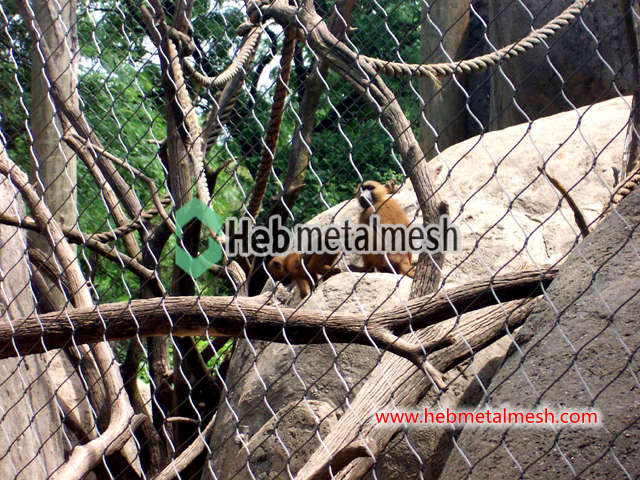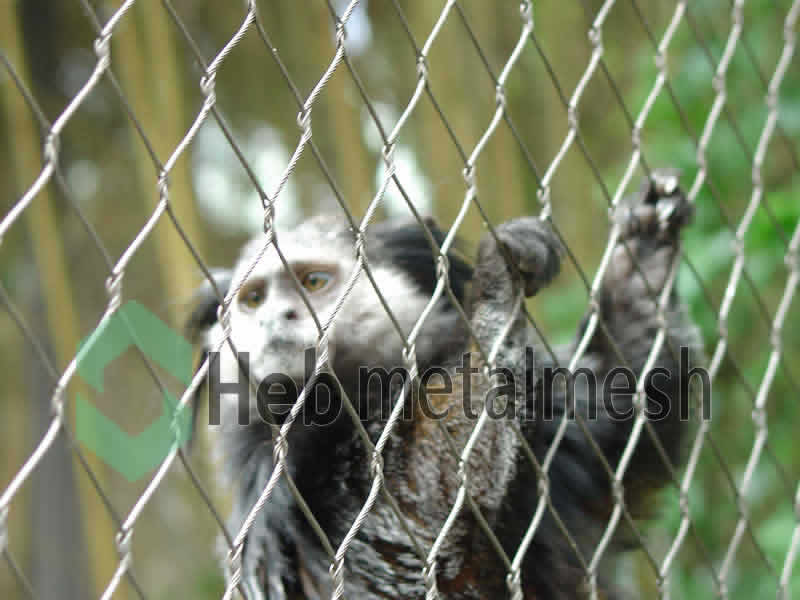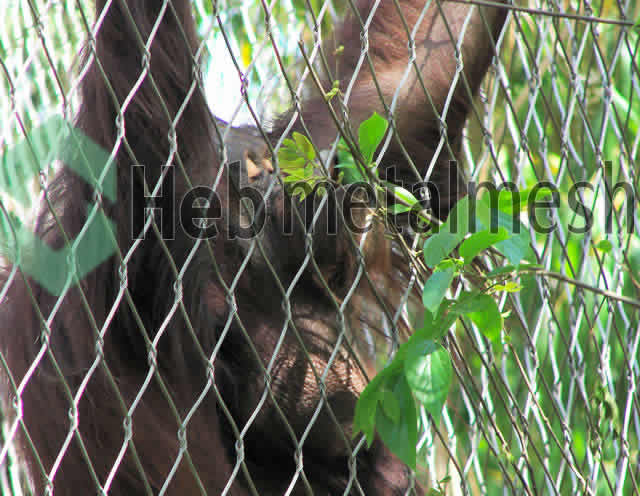Introduction to Stainless Steel Fence Mesh
Choose a best specification and size for your need.
Contact for your customized panel size and need.
Stainless steel fence mesh is increasingly recognized as an essential component in the design and construction of animal habitats. This innovative fencing solution is defined by a network of stainless steel wires, woven tightly to create a durable, yet permeable barrier that ensures the safe confinement of various animal species. Its versatility makes it an ideal choice for a broad range of applications, from livestock enclosures to wildlife sanctuaries.
The primary materials used in the production of stainless steel fence mesh include high-grade stainless steel alloys, which are known for their resistance to corrosion, strength, and malleability. This unique combination results in a material that not only withstands the test of time, but also maintains its aesthetic appeal, making it suitable for settings that require both functionality and visual consideration. Unlike traditional fencing options such as wood or chain link, stainless steel offers a longer lifespan and lower maintenance needs, which is particularly advantageous for animal habitats where wear and tear can occur more frequently.
The advantages of utilizing stainless steel fence mesh are substantial. First and foremost, its strength ensures that animal inhabitants cannot easily breach the barrier, which is crucial for their safety as well as that of nearby facilities. Additionally, the material’s inherent durability minimizes the risk of rust and deterioration, ensuring that the fence for animals retains its structural integrity over many years. Moreover, the sleek and modern look of stainless steel enhances the overall appearance of an enclosure, blending seamlessly into natural surroundings while serving its primary protective function. As the demand for effective animal housing solutions grows, the adoption of stainless steel fence mesh emerges as a logical choice for ensuring both durability and aesthetic quality.
The Importance of Animal Habitats
Creating secure and safe habitats for animals is vital in various settings, including zoos, wildlife reserves, and personal enclosures. Such environments serve not only to protect the animals but also to enhance their overall well-being. Properly designed habitats allow animals to exhibit natural behaviors, which is essential for their physical and psychological health. Animals confined within these spaces should have adequate room to roam, play, and rest, directly affecting their quality of life.
One of the critical elements in maintaining the integrity of these habitats is the installation of effective fencing. When constructing enclosures, it is imperative to select a durable barrier, such as a fence for animals, that ensures both security and comfort. The choice of fencing material can significantly influence the conditions within the habitat. For instance, stainless steel fence mesh is not only strong and resilient but also provides visibility. This transparency helps keep animals engaged with their surroundings, reducing stress and promoting a healthier environment.
Moreover, suitable fencing deters potential threats from outside the enclosure. This protective barrier ensures that animals are safeguarded from predators and human interference, allowing them to thrive in a controlled yet naturalistic setting. Additionally, the right fencing can also help in the management of animal habitats; for example, stainless steel mesh can minimize escape risks, thereby safeguarding both the animals and their keepers.
Incorporating high-quality fencing, like stainless steel fence mesh, therefore, plays a foundational role in establishing robust animal habitats. It is critical to prioritize safety and comfort when creating these environments, ensuring that animals not only survive but flourish in their designated spaces.
Features of Stainless Steel Wire Rope Mesh
Stainless steel wire rope mesh has emerged as a preferred material for constructing enclosures and barriers designed for various animal habitats. One of its most notable features is its exceptional corrosion resistance, which ensures longevity and durability even in harsh environmental conditions. Unlike traditional fencing materials, which may degrade over time due to rust and wear, stainless steel maintains its structural integrity, making it a reliable choice for protecting animals and their surroundings.
In addition to its corrosion resistance, the strength of stainless steel wire rope mesh cannot be overstated. Engineered to withstand significant tension and impact, this type of fencing is well-suited for containing larger animals or those that may exert considerable force against their enclosures. The tensile strength of stainless steel helps prevent breakage or bending, thereby providing a secure and safe environment for animals, while also assuring caretakers that the materials will not fail unexpectedly.
Another advantageous feature is its flexibility. Stainless steel wire rope mesh can be easily configured to fit various shapes and sizes, accommodating the specific layout of different habitats. This adaptability allows for creative fencing solutions that are not only functional but also visually appealing. Caregivers can design enclosures that blend seamlessly with the natural landscape, enhancing the aesthetic value of animal habitats without compromising security.
Furthermore, stainless steel fencing requires minimal maintenance compared to other fencing materials. Its inherent properties mean it does not need frequent painting or treating, reducing labor and costs associated with upkeep. This makes it a cost-effective choice in the long run. Overall, the combination of corrosion resistance, strength, flexibility, and low maintenance makes stainless steel wire rope mesh an ideal option for anyone in need of a reliable fence for animals.
Design Versatility and Aesthetic Appeal
Stainless steel fencing presents an array of design possibilities that cater to the varied aesthetic needs of different animal habitats. The inherent qualities of stainless steel, such as its durability, resistance to corrosion, and sleek finish, render it an ideal material for creating enclosures that are not only functional but also visually appealing. The versatility of this fencing allows for a wide range of designs, including various heights, spacing and mesh configurations, ensuring that it can be tailored to fit specific requirements while also enhancing the overall look of the environment.
Customizable options in stainless steel fencing enable designers and builders to incorporate elements that align with the surrounding decor or theme of the animal habitat. For instance, in a zoo setting, the fence for animals can be designed to mirror the natural elements found within the habitats, blending seamlessly with plants, rocks, and water features. This not only promotes an immersive experience for visitors but also ensures that the wildlife is housed in a secure, safe manner. The modern look of stainless steel can also add a touch of sophistication to private animal sanctuaries, where aesthetics are just as crucial as the functional aspects of enclosures.
Moreover, stainless steel fencing can be treated or coated with various finishes to achieve specific visual effects, further enhancing its aesthetic appeal. Options such as textured or colored finishes can be employed to create a unique atmosphere and complement the surrounding environment. For example, a brushed finish can create a subtle, understated elegance, while a brightly colored coating can make a bold statement. Ultimately, the design versatility offered by stainless steel fencing allows for the creation of enclosures that are not only practical and secure but also elevate the visual experience of the space they inhabit.
Comparing Stainless Steel Mesh to Other Fencing Options
When considering fencing for animals, various materials are available, each with distinct advantages and disadvantages. This comparative analysis focuses on stainless steel wire mesh in relation to wood, plastic, and traditional metal fencing, providing insights into their effectiveness and suitability for animal habitats.
Wood fencing has long been a popular choice for animal enclosures due to its natural appearance and ability to blend into the environment. However, wood is prone to rot, insect infestation, and weather-related degradation, which can compromise its structural integrity over time. Maintenance costs can be high, as regular treatments are necessary to preserve its durability. In contrast, stainless steel wire mesh offers a longer lifespan, as it resists corrosion and does not succumb to pests or environmental factors, making it a more reliable option for fencing for animals.
Plastic fencing has emerged as an alternative, often promoted for its light weight and ease of installation. While it requires minimal maintenance, plastic can become brittle over time, especially in extreme temperatures, leading to potential breakage. Furthermore, its aesthetic appeal may not match that of natural materials, which could be a consideration for some animal habitats. Stainless steel, on the other hand, combines functionality with visual appeal, presenting a polished and modern look while providing optimum security for enclosed animals.
Traditional metal fencing, such as chain-link or wrought iron, is favored for its strength. However, it can be less flexible in terms of customization and is vulnerable to rust without adequate protective treatments. Stainless steel wire mesh surpasses traditional options, offering enhanced flexibility in design while maintaining superior strength and resilience. Its capability to withstand harsh conditions ensures it remains a top choice for fencing for animals.
Overall, the analysis shows that while each fencing option has its merits, stainless steel wire mesh stands out as the optimal choice for animal habitats, balancing durability, aesthetics, and safety effectively.
Durability and Lifespan of Stainless Steel Fencing
Stainless steel fencing has gained prominence in the construction of enclosures and habitats for animals due to its exceptional durability and longevity. Unlike traditional fencing materials such as wood or vinyl, stainless steel is resistant to corrosion, rust, and the negative impacts of weather conditions. This resilience is particularly beneficial for outdoor environments, where fences for animals are routinely exposed to humidity, rain, and varying temperatures.
Statistics indicate that stainless steel fencing can last up to 50 years or more with minimal maintenance. Researchers have conducted numerous studies that reveal stainless steel’s ability to retain structural integrity even after prolonged exposure to harsh environmental elements. This longevity translates into significant cost savings over time as the need for repairs and replacements diminishes substantially. By investing in high-quality stainless steel fencing, animal habitats can benefit not only from durability but also from the aesthetic appeal of sleek and modern designs.
Furthermore, stainless steel exhibits high tensile strength, which makes it difficult for animals to escape or predators to intrude. This strength is vital for ensuring the safety and security of the animals within the enclosure. When selecting a fence for animals, considering materials such as stainless steel can provide both peace of mind and a visually pleasing environment. Its robustness contributes to a sustainable solution that combines function and elegance, supporting the overall health and well-being of the animals.
In conclusion, the durability and lifespan of stainless steel fencing make it a preferred choice for animal enclosures. Investing in stainless steel may incur higher initial costs, but its long-term benefits in terms of reduced maintenance and replacement expenses highlight its cost-effectiveness. As such, stainless steel emerges as a wise option for maintaining secure, effective, and aesthetically pleasing habitats for animals.
Installation Process for Stainless Steel Fence Mesh
The installation of stainless steel fence mesh for animal habitats requires careful planning and execution to ensure durability and effectiveness. Prior to beginning the installation process, it is essential to gather all necessary materials, including stainless steel mesh rolls, posts, clamps, and tools such as a tensioning device, wire cutters, and a drill. One of the first considerations is selecting the appropriate height and gauge of the fence for animals, based on the species being contained and their specific needs.
Commencing with site preparation, it is advisable to clear the area where the fence will be installed, removing any debris, rocks, or vegetation that could interfere with the fence’s stability. After clearing the area, mark the layout using stakes and string to ensure a straight alignment. This will aid in accurately placing the posts, which should be installed at regular intervals, typically 6 to 8 feet apart, depending on the mesh’s gauge and the overall design.
Once the posts are set in concrete, the next step is to attach the stainless steel mesh. When unrolling the mesh, it is crucial to maintain tension to keep the fence taut and prevent sagging, which could pose a risk to the animals contained within. Starting from one end, secure the mesh to the posts using clamps or staples, ensuring that it is firmly affixed. Pay special attention to corners and gates, as these areas require additional reinforcement.
Potential challenges during installation may include uneven terrain or the mesh tearing. In such cases, it is advisable to use ground anchors or additional support cables for stability. If tearing occurs, it is crucial to have extra pieces of stainless steel mesh available for repairs. After the installation, conduct a thorough inspection to ensure all components are securely in place, and the fence is reliable for keeping animals safe. With proper planning and execution, the installation of a stainless steel fence mesh can provide a lasting and effective barrier for animal habitats.
Maintenance and Care for Stainless Steel Fencing
Proper maintenance and care of stainless steel fence for animals is essential to ensure its longevity and appearance. While stainless steel is known for its durability, it still requires regular attention to maintain its integrity and aesthetic appeal. The first step in this maintenance process is regular cleaning. It is advisable to use a soft cloth or sponge along with a mild detergent solution to clean the surface. For more stubborn stains or residues, a soft bristle brush can be utilized. It is important to avoid abrasive cleaners and tools that may scratch the surface, which can compromise the protective layer of the stainless steel.
Inspection is another critical aspect of maintaining a stainless steel fence for animals. Regularly checking for signs of wear, rust, or corrosion can help identify issues before they escalate into significant problems. Inspecting the joints, hinges, and any connecting hardware is essential, as these are often the first areas to show signs of distress. If any components are found to be loose or damaged, they should be addressed promptly to prevent further deterioration.
Repairs for stainless steel fencing should be approached with caution. When dealing with minor rust spots, utilizing a non-abrasive rust remover can be effective. For deeper issues, such as structural damage, it may be necessary to consult with a professional to assess whether the damage warrants repair or replacement of the entire section. Ensuring that all repairs are conducted using compatible materials with similar corrosion resistance properties is crucial in preserving the fence’s effectiveness and appearance over time.
In summary, ensuring proper maintenance of a stainless steel fence for animals through regular cleaning, thorough inspection, and timely repairs can significantly extend its lifespan while contributing to the overall safety and well-being of the animals in its enclosure.
Conclusion: Why Choose Stainless Steel Fence Mesh for Animal Habitats
In the realm of animal enclosures, the choice of fencing material is crucial for ensuring the safety and well-being of the animals within. Stainless steel fence mesh offers a multitude of benefits that make it a superior option for animal habitats. Firstly, its durability is unparalleled. Stainless steel is resistant to rust and corrosion, allowing it to withstand various environmental conditions without succumbing to wear and tear. This longevity translates into cost-efficiency, reducing the need for frequent replacements or repairs, which is particularly important for those managing extensive animal facilities.
Moreover, the aesthetic appeal of stainless steel mesh cannot be overlooked. Its sleek, modern appearance complements any landscape while providing unobstructed views of the animals. This transparency not only enhances the visual experience for visitors but also allows for better monitoring of animals, ensuring their welfare. Unlike traditional wooden or barbed wire fences, stainless steel fence for animals exhibits a blend of function and style, making it an attractive option for zoos, farms, and private properties alike.
Another compelling reason to opt for stainless steel fencing is its commitment to animal welfare. The smooth edges of the mesh prevent injuries, while the structure can offer a secure barrier without impeding natural behaviors. When choosing a fence for animals, it is paramount to consider the safety and comfort of the inhabitants. Stainless steel mesh effectively fulfills this requirement, promoting a healthy and secure environment for animals.
Ultimately, when weighing the choices for fencing solutions, stainless steel wire rope mesh stands out as the preferred choice. Its combination of durability, aesthetic value, and commitment to animal welfare positions it as the optimal fencing solution, deserving of consideration for anyone invested in creating safe and appealing animal habitats.


